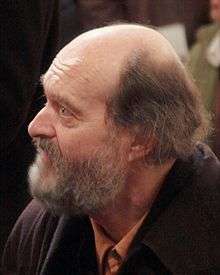Fratres
Fratres (Brothers) is a composition by the Estonian composer Arvo Pärt exemplifying his tintinnabuli style of composition.[1] It is three-part music, written in 1977, without fixed instrumentation and has been described as a “mesmerising set of variations on a six-bar theme combining frantic activity and sublime stillness that encapsulates Pärt’s observation that ‘the instant and eternity are struggling within us’.”[2]
| Fratres | |
|---|---|
| Instrumental music by Arvo Pärt | |
 The composer in 2008 | |
| Form | Variations |
| Composed | 1977 |
| Scoring | varied |
Structure
Structurally, Fratres consists of a set of nine chord sequences, separated by a recurring percussion motif (the so-called "refuge"). The chord sequences themselves follow a pattern, and while the progressing chords explore a rich harmonic space, they have been generated by means of a simple formula.[3]
Fratres is driven by three main voices. The low and high voice are each restricted to playing notes from the D harmonic minor scale (D, E, F, G, A, Bb, C#); the middle voice is restricted to the notes of the A minor triad (A, C, E). The entire piece is accompanied by drones in A and E, which are primarily heard in the refuge between each sequence.
The chords are created by the movement of the three voices: the low voice starts at C#; the high voice starts at E. Both the low and high voices are moved up or down the D harmonic minor scale at the same time, with the direction of the movement depending on the position within the sequence. The middle voice starts at A and plays a different pattern (A, E, E, C, C, C, C, A, A, E, E, C, C, A). The generated chords create harmonic ambiguity, since both C# and C are present, yielding an A major or A minor feel.
In film
The composition has been used for many films and documentaries. Notable usages include:
- 1987 film Rachel River
- 1996 film Mother Night performed by Tasmin Little (violin) and Martin Roscoe (piano)
- 1997 German film Winter Sleepers
- 1999 eight-part PBS documentary New York: A Documentary Film directed by Ric Burns
- 2005 six-part BBC documentary Auschwitz: The Nazis and the ‘Final Solution’ produced by Laurence Rees, used the composition performed in 1997 by the Hungarian State Opera Orchestra, conducted by Tamás Benedek
- 2006 autobiographical film La Morte Rouge directed by Victor Erice
- 2007 film There Will Be Blood directed by Paul Thomas Anderson
- 2013 film To the Wonder directed by Terrence Malick
- 2013 film The Place Beyond the Pines directed by Derek Cianfrance
- 2013 film Violette directed by Martin Provost
- 2015 film El Club directed by Pablo Larraín
- 2017 documentary film Mountain directed by Jennifer Peedom
- 2017 film Félicité directed by Alain Gomis
Versions
The piece is often performed by violin and piano, but is also familiar in versions for larger forces such as a chamber orchestra. Performance by early music specialists has also been endorsed.[4]
All existing versions so far are composed as follows:
- Versions of the original music in three voices
- chamber orchestra (1977)
- four, eight or twelve cellos (1982)
- string quartet (1989)
- octet of winds and percussion (1990)
- string and percussion orchestra (1991)
- band of metal instruments (2004)
- three recorders, percussions and cello or viola da gamba (2009)
- Versions of music in three voices with individual variations
- violin and piano (1980)
- cello and piano (1989)
- violin, string orchestra and percussion (1992)
- trombone, string orchestra and percussion (1993)
- cello, string orchestra and percussion (1995)
- guitar, string orchestra and percussion (2000)
- violet and piano (2003)
- four percussionists (2006)
- viola, string orchestra and percussion (2008)
- saxophone quartet (2010)
In other compositions
Jazz pianist Aaron Parks incorporated elements of Fratres into his composition "Harvesting Dance," heard on his album Invisible Cinema and on Terence Blanchard's album Flow.[5]
References
- Zivanovic, Rade (2012). "Arvo Part's Fratres and his Tintinnabuli Technique". hdl:11250/138506. Cite journal requires
|journal=(help) - Arvo Pärt, Sinfini Music website
- Linus Åkesson (2007-12-03). "Fratres". Retrieved 2007-12-03.
- "Fratres (concert)". Arvo Part Centre. Retrieved 2020-05-08.
- Frank J. Oteri (2014). "Aaron Parks: Make Me Believe A Melody". Retrieved 2014-06-17.
External links
- The 1997 release by the Hungarian State Opera Orchestra, used in the 2005 BBC documentary Auschwitz: The Nazis and the ‘Final Solution’
- An Official Video of London-based violinist Lana Trotovšek performing the version for violin and piano with pianist Yoko Misumi
- Free recording of Fratres for Cellos by the Columbia University Orchestra.
- A Remixed version for Violin and Piano by Beats Antique of Oakland California